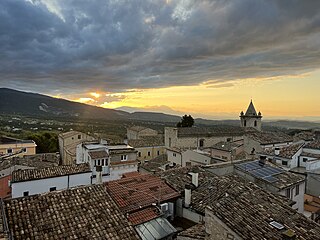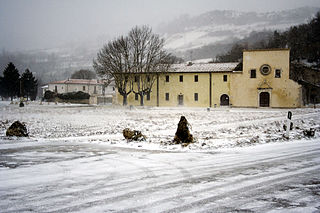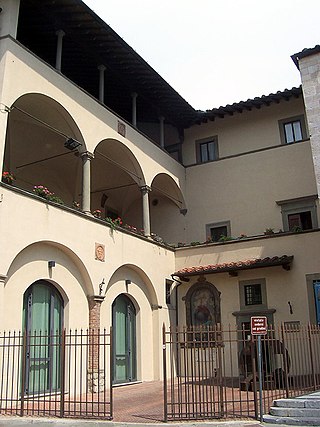 Museo civico di Cerchio | |
| Location | Cerchio |
|---|---|
| Type | Religious art |
Museo civico di Cerchio (Italian for Civic Museum of Cerchio) is a museum of religious art in Cerchio, Province of L'Aquila (Abruzzo). [1]
 Museo civico di Cerchio | |
| Location | Cerchio |
|---|---|
| Type | Religious art |
Museo civico di Cerchio (Italian for Civic Museum of Cerchio) is a museum of religious art in Cerchio, Province of L'Aquila (Abruzzo). [1]
The history of the museum begins after the 1915 earthquake: the vault of the Church of the Madonna delle Grazie collapsed and was subsequently restored. During the restoration, works from the same church and other city places of worship were stored in some rooms of the church. In the rooms next to the mother church of Santa Maria delle Grazie, once home to a convent of the Discalced Augustinians, one part was reserved for the prior's residence, while the other housed the museum of sacred art. At the end of World War II, the liberated rooms hosted collections of silverware and costumes, while the cloister was set up as a museum of farming and pastoral traditions.
The civic museum, initiated by historian Fiorenzo Amiconi and officially established on October 21, 1986, is housed in six rooms. The collected works range roughly from the 14th to the 19th century. In 1990, the interior museum space was expanded with the ethnographic section and the section on farming and pastoral civilization, and later with the section dedicated to the Republic of Italy. [2] [3]
The museum, which was closed for a period after the 2009 L'Aquila earthquake, was restored and reopened on September 1, 2018. [4]

The province of L'Aquila is the largest, most mountainous and least densely populated province of the Abruzzo region of Italy. It comprises about half the landmass of Abruzzo and occupies the western part of the region. It has borders with the provinces of Teramo to the north, Pescara and Chieti to the east, Isernia to the south and Frosinone, Rome and Rieti to the west. Its capital is the city of L'Aquila.

The province of Chieti is a province in the Abruzzo region of Italy. Its provincial capital is the city Chieti, which has a population of 50,770 inhabitants. The province has a total population of 387,649 inhabitants as of 2017 and spans an area of 2,599.58 square kilometres (1,003.70 sq mi). The province contains 104 comuni. Its provincial president is Mario Pupillo.

Guardiagrele is a town and comune in the province of Chieti, part of the Abruzzo region of central Italy. It is in the foothills of the Maiella mountain at an elevation of around 576 metres (1,890 ft). Its population numbers about 10,000.

Altino is a comune and town in the province of Chieti in the Abruzzo region of southern Italy. It is located on a rock spur commanding the valley of the Aventino river. The valley is richly cultivated with orchards, fruit, grapes and olives.

Bugnara is a comune and village in the province of L'Aquila in the Abruzzo region of southern Italy. It is one of I Borghi più belli d'Italia.

Cerchio is a comune and town in the province of L'Aquila in the Abruzzo region of southern Italy.

Tourism in Abruzzo has become one of the most prosperous sectors in the economy of Abruzzo, and in recent years has seen a remarkable growth attracting numerous tourists from Italy and Europe. According to statistics, in 2021 arrivals totaled 1,330,887. A total of 5,197,765 arrivals were tourists, a figure that puts the region seventeenth among the Italian regions for numbers of tourists per year. A moderate support to tourism is also given to the Abruzzo Airport with many low cost and charter flights connecting the entire region with the rest of Europe.

The Abbey of the Holy Spirit at Morrone, known by various titles, is a former monastery some five kilometers outside of the town of Sulmona, at the base of Monte Morrone, in the Province of L'Aquila, region of Abruzzo, Italy.

Museo delle genti d'Abruzzo is an ethnographic Museum in Pescara, Abruzzo.

Museo d'Arte Sacra della Marsica is a museum of religious art in Celano, Province of L'Aquila (Abruzzo).

Museo archeologico Francesco Savini is an archaeology museum in Teramo, Abruzzo.

Museo civico aufidenate is an archaeology museum in Castel di Sangro, Province of L'Aquila (Abruzzo).

Museo diocesano di Sulmona is a museum of religious art in Sulmona, Province of L'Aquila (Abruzzo).

Museo diocesano di Lanciano is a museum of religious art in Lanciano, Province of Chieti (Abruzzo).

Museo del duomo di Guardiagrele is a museum of religious art in Guardiagrele, Province of Chieti (Abruzzo).

Museo capitolare di Atri is a museum of religious art in Atri, Province of Teramo (Abruzzo).

The Cathedral museum of Prato, Italy was founded in 1967 in a few rooms of the Bishop's residence and in 1976 grew to include items from both the Cathedral of Saint Stephen and the diocesan territory.
The Diocesan Museum of Sacred Art (MuDAS) in Arezzo was founded in 1963 but opened regularly to the public only in 1985, and was housed in several rooms above the sacristy of the Cathedral of San Donato. In 2011 it was relocated to the first floor of the bishop's residence. The museum exhibits works of art and liturgical items, from the 12th to the 19th centuries, that come from the cathedral and other churches in the diocesan territory, significant for their religious and cultural significance to Arezzo and the surrounding area. Highlights of the museum include several works of Giorgio Vasari and the Pace di Siena.

The Museo Interdisciplinare Regionale (MuMe). or Regional Museum of Messina (Italian - Museo regionale interdisciplinare di Messina), is an art museum located on the northern coast of the city of Messina, Sicily, Italy. MuMe illustrates the development of art and culture in Messina from the 12th to the 18th centuries, with outstanding figures such as the renowned artists Andrea della Robbia, Antonello da Messina, Girolamo Alibrandi, Caravaggio (Michelangelo Merisi), and Polidoro da Caravaggio.
The Diocesan Museum of Palermo is a museum of religious art in Palermo on Sicily, housed in a number of rooms in the Palazzo Arcivescovile opposite Palermo Cathedral.